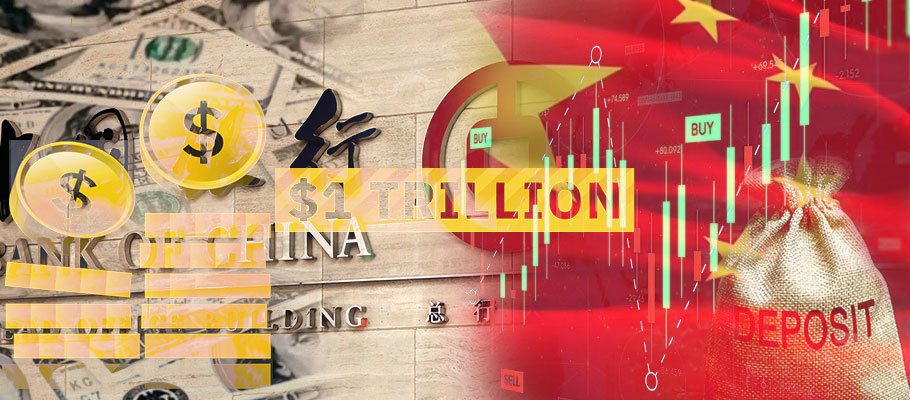
Published: June 28th, 2021
At the end of May, Chinese commercial banks held a record $1.38 trillion of foreign exchange. According to the People’s Bank of China, a huge proportion of these funds were held in deposits. It is the first time that the stockpile has surpassed the $1 trillion threshold.
Chinese commercial banks’ accumulation of foreign currency deposits surged past $1 trillion for the first time at the end of May. The achievement allowed Beijing to give greater leeway for capital to trickle out of the country.
The pool has swelled steadily corresponding with the increasing demand for Chinese goods during the pandemic. The demand pushed up the exporters’ foreign earnings. Besides, the country’s resilient economy and the fortified currency have attracted overseas investors to exchange dollars for yuan to invest in Chinese bonds and stocks.
Foreign currency held as bank deposits shot up more than $260 billion year-on-year in May. Traditionally, Chinese banks do not have channels of using their foreign currency deposits; a mismatch that helped increase the inflows.
Besides, the only viable option is to sell it onshore, an option that only heaps pressure on the yuan to strengthen. The currency’s index is already hovering near a five-year high compared to a basket of its peers. Yuan’s situation is pushing Beijing to rectify its forex market and soften capital controls.
Market analysts say that such a move would make it easy for local investors to buy overseas assets. Linan Liu, the greater China macro strategist at Deutsche Bank AG in Hong Kong, said that strong capital inflows give China a good opportunity to undertake capital account reforms while loosening two-way capital inflows.
Liu said he expects Beijing to use investment schemes to further relax capital inflows. Overall, commercial lenders held a record $1.38 trillion in foreign currency at the end of May. According to the People’s Bank of China (PBoC), the majority of the accumulation was held in deposits.
The PBoC report said that lenders utilized a sizable proportion of the cash to loan onshore and offshore firms. At the same time, the central bank’s foreign reserves shot to a five-year high in the same month. PBoC attributes the accumulation o rapid capital inflows. The bank’s report shows that overseas investors gobbled up about 1 trillion yuan (approx. 154 billion) of onshore bonds in the past 12 months, enticed by comparably high yields on yuan-denominated debts.
Besides, the country’s exports increased because its factories resumed operations while the rest of the world was still struggling to disentangle from the clutches of the pandemic, pushing China’s trade surplus to a record high.
The surge in inflows has pushed down dollar deposit rates in China close to all-time lows. At the moment, the figure is only about 33% of the equivalent funding costs in the U.S. Such a dramatic divergence is encouraging banks to buy more yuan against the dollar. However, such a scenario is worrying Beijing that a very strong yuan might invite hot money inflows, thereby hurting Chinese exporters.
Already PBoC has initiated steps to bring down the dollar liquidity. The measures include relaxing the capital controls that were implemented following the yuan’s devaluation half a decade ago. Besides, the central bank has expanded the quota of overseas assets that onshore investors can buy to a record in June.
Beijing is also planning to establish a trading link between Hong Kong and the mainland for wealth products. George Magnus, a research associate at Oxford University’s China Centre, said it is possible to look at the actions as two sides of a conflicting coin.
He said that some Chinese officials would prefer to see foreign exchange liquidity as an achievement while others choose to worry that the policies are flighty. Magnus added that markets appear more stable when inflows are streaming in steadily. However, it becomes a problem that distorts financial stability when the direction of flow changes.
The economist cautions that the increasing dollar deposits are as temporary as they are random. He foresees them slowing as soon as other nations begin the recovery journey from the pandemic.
Magnus said that while the inflow stretches, it offers China an opportunity to undertake reforms and relax its tight grip on its tightly controlled capital borders. Other market experts easily agree with Magnus’s comments.
Becky Liu, head of China macro strategy at Standard Chartered Plc in Hong Kong, said China should take any available chance to flush dollar liquidity. She added that doing so would balance the country’s otherwise distorted cross-border flows.
Liu foresees China constantly working on corrective measures two to three years to come.
According to her, much of the work will consist of widening the channels through which funds leave the country. Surprisingly, the Chinese government seems to be completely in tandem with the general mood.
Chen Jia, a spokesperson for the State Council, announced recently that the country has increased the amount of forex deposits that commercial banks should hold as reserves. The directive, which became effective on June 15, hopes to curb sell-offs of foreign currency following the yuan’s record high surge.
Effectively, the increase in the reserve ratio on forex deposits climbs by 7% from 5%. Beijing hopes the move would help financial institutions improve their forex liquidity management. The country implemented a similar move almost fifteen years ago when it increased the ratio from 4% to 5%.
The 2007 move secured forex supply in the onshore market and heightened the cost of foreign currency-dominated loans.
Guan Tao, the chief economist at BOC International, thinks that increasing the forex deposit reserve ratio is a clever move. According to him, China has just crafted a means of mopping out some $20 billion worth of forex liquidity in its onshore market.
Meanwhile, the central parity of the yuan against the U.S. dollar stood at 6.3682 at the beginning of June, the strongest number since mid-May 2018.